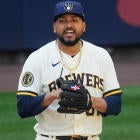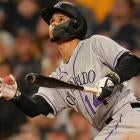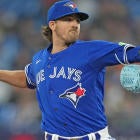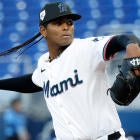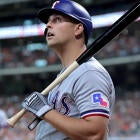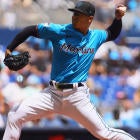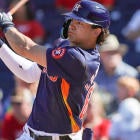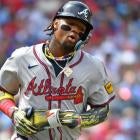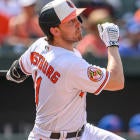2015 Rankings: 1B | 2B
| C
| SP
| 3B
| SS
| OF
Relief pitcher is goofy. The value of the position as a whole varies widely from format to format, and the value of the parts therein is primarily a product of role. Granted, role shapes player value at every position, but not to the extent that a change in role can take a player from useful to useless (and vice versa) in the blink of an eye.
So as you might expect, any ranking of relief pitchers this time of year comes with a caveat: Roles have yet to be determined.
David Robertson, Huston Street, Francisco Rodriguez, Rafael Soriano, Casey Janssen and LaTroy Hawkins are among the closers eligible for free agency. Maybe they'll re-sign with their 2014 teams, but maybe they won't. Maybe they'll sign elsewhere, sending an incumbent closer to middle relief, or maybe they'll accept a lesser role themselves. Maybe the teams they leave behind will promote a closer from within, or maybe they'll swap out one free agent or another. And that doesn't even account for trades, which are sure to happen.
Given the array of possibilities, it's not crazy to think half the league could have a different closer at the start of 2015 than we anticipate now. So more than at any other position, you'll want to take these rankings with a grain of salt.
Top 12 relief pitchers for 2015:
1. Alex Wood, SP/RP, Braves
2. Carlos Carrasco, SP/RP, Indians
3. Craig Kimbrel, RP, Braves
4. Greg Holland,
RP, Royals
5. Aroldis Chapman, RP,
Reds
6. Kenley Jansen, RP, Dodgers
7.
Dellin Betances, RP, Yankees
8. David Robertson, RP, Yankees
9. Sean Doolittle, RP, Athletics
10. Huston Street, RP, Angels
11. Cody Allen,
RP, Indians
12. Mark Melancon, RP,
Pirates
You'll notice right away that the top two aren't actually relief pitchers but starting pitchers masquerading as relief pitchers -- or SPARPs, as we've come to know them. In Head-to-Head points leagues especially, they can be hugely valuable.
Of course, they still have to be good to be worth your while, but Wood and Carrasco are certainly that, the former compiling a 1.92 ERA, 1.03 WHIP and 9.1 strikeouts per nine innings over his final 11 starts and the latter delivering a 1.30 ERA, 0.81 WHIP and 10.2 strikeouts per nine over his final 10. If you took what they averaged on per-start basis (for the season, not just those insane stretches) and multiplied it over 32 starts, each would have outscored the top closer in 2014, Holland, by more than 30 points -- or about the difference between Carlos Gomez and Denard Span. In Rotisserie leagues, you could make a case for the elite closers over them just because closers are in higher demand overall, but even then, it's a stretch.
The actual closers begin at No. 3 with Kimbrel, who finished just a point and half behind Holland in 2014. The two have been eerily similar the last couple years and, along with Chapman, give the position what has become a predictable top tier. Chapman might actually have the most upside of the three considering he averaged an astonishing 17.7 strikeouts per nine innings in 2014 -- a record for a pitcher with at least 50 innings -- but he also has the most health concerns and pitches for the team that yields the fewest save opportunities.
Of course, with more and more teams introducing their best relievers to the closer role (instead of sticking with the old standbys, as happened for much of the 1990s and 2000s), the line between tiers continues to blur, which diminishes the value of Kimbrel, Holland and Chapman overall. Jansen was already just a half step behind them, offering 100-strikeout potential of his own, and Robertson immediately took to the role with 13.4 strikeouts per nine innings -- a rate that landed him behind only Chapman, Jansen and Kimbrel among full-time closers. Doolittle was a victim of poor timing, missing out on the A's best run at the beginning of the season, but he still had 12.8 strikeouts per nine innings along with a 0.73 WHIP thanks to an unreal 11-to-1 strikeout-to-walk ratio. In terms of advanced stats, he had the second-lowest FIP of any closer in 2014, behind only Chapman.
But he didn't have the second-lowest FIP of any pitcher on this list. That honor went to Betances, who I actually rank ahead of Doolittle under the assumption he inherits the closer role in New York. Robertson is a free agent, remember, and though the Yankees presumably have the resources to re-sign him or bring in another free agent to handle the role, they may not want to after watching Betances strike out 135 batters with a 1.40 ERA and Doolittle-like 0.78 WHIP. For a pitcher with 90 innings, that's unheard of. Of course, he probably won't get 90 innings if he moves to the closer role because the Yankees probably won't ask him to go multiple innings as often, but as good as his ratios are, it's a worthy tradeoff in Fantasy.
Judging by his 2.07 ERA, 1.06 WHIP and 11.8 strikeouts per nine innings, Allen brings elite potential to the position as well, but since we have the latitude to nitpick here, his walk and home run rates leave a bit to be desired. And for whatever reason, he struggled to find save opportunities for a team on the verge of contention. That's reason enough to play it safe with Street, who's coming off a career year.
With just 11 walks in 71 innings, Melancon was like Doolittle, only without the Kimbrel-like strikeout rate. It was his second straight year with a sub-2.00 ERA and sub-1.00 WHIP. He rounds out what to me is fairly conclusive top 12, though certainly the order leaves room for debate. What's crazy is that even beyond these 12, you'll still find relievers with top-12 potential. What they bring to the table, though, isn't as clearly defined.
Next 12 relief pitchers for 2015:
13. Zach Britton, RP, Orioles
14. Drew Storen,
RP, Nationals
15. Jake McGee, RP,
Rays
16. Jonathan Papelbon, RP,
Phillies
17. Drew Pomeranz, SP/RP,
Athletics
18. Koji Uehara, RP, Red
Sox
19. Steve Cishek, RP, Marlins
20.
Trevor Rosenthal, RP, Cardinals
21. Fernando Rodney, RP, Mariners
22. Joaquin Benoit, RP, Padres
23. Glen Perkins,
RP, Twins
24. Francisco Rodriguez,
RP, Brewers
The Orioles gave Fantasy owners a 50-save closer in both 2012 and 2013, and Britton might have made it three years in a row if he had gotten the job prior to mid-May. His 1.65 ERA and 0.90 WHIP were as impressive as anyone's, and he's obviously in a good situation. But his limited strikeout potential lends itself to Jim Johnson comparisons, which will probably conjure more bad memories than good. Am I really all that worried? No, I think you'll be pretty happy with Britton. But again, we have the latitude to nitpick here.
Storen, who didn't assume the closer role until September but has thrived in it before, is kind of in the same boat. Judging by the numbers that matter -- his 1.12 ERA was second among all relievers with at least 50 innings, for crying out loud -- he was outstanding, but judging by the numbers that help predict the numbers that matter, he was ... a little less than outstanding. In case you can't tell, I'm struggling to find bad things to say about good pitchers.
But I can't stop yet. McGee was probably the third-best left-handed reliever to Chapman and Doolittle this year, and after taunting Fantasy owners with him for years, the Rays finally gave him the keys to the ninth inning in late June. But it was on a trial basis. Before opting out of his contract, manager Joe Maddon was talking like he'd go by committee in 2015, so hopefully his replacement takes a different tack. In that scenario, McGee would probably rank as high as 10th among relievers.
Just after Papelbon, who showed in 2014 he's not going anywhere (much to the chagrin of Phillies fans), seems like the appropriate place for the next-best SPARP. If you took what he averaged on a per-start basis and multiplied it over 32 starts, Pomeranz would have ranked 16th among relievers in Head-to-Head points leagues this year. Of course, that was with the innings limitations that accompany a back-and-forth role. He has the potential for more as a full-time starter, his projected role for 2015, but since he still has some issues with walks and home runs, he has his share of detractors. I'd be thrilled to get him as my second reliever, though.
Besides, the relievers after him, unlike Britton, Storen and McGee, aren't exactly beyond reproach. Uehara, Cishek and Rosenthal all have some of the components of ace relievers, but they all have warts, too. Uehara collapsed in September and may not be able to handle a closer workload at age 39, Rosenthal's walk rate of 5.4 per nine innings would have lost most closers their jobs, and Cishek ... well, I don't really know what's wrong with Cishek. He's just not as good as he should be. Let's just say he has consistency issues.
Benoit's 1.49 ERA, 0.77 WHIP and 10.6 strikeouts per nine innings in 2014 give him the look of an elite closer, and I'd like him more if I felt I could trust him to stay put ... in more ways than one. He missed most of September with shoulder discomfort and is entering the final year of his contract for an expected non-contender. Any team would love to have him as a setup man, which is the role he's more accustomed to filling.
Perkins has been great in the past, but he has his own injury concerns after being shut down in mid-September with a forearm strain, which is often a precursor to elbow problems. Rodriguez at 24th may offend some since he was the third-best closer in points leagues in 2014, but his 4.22 ERA over his final 50 appearances may prevent him from getting another closer gig. And even if it doesn't, it could be a bumpy ride.
Among the near misses, Hector Rondon had a 0.62 ERA in the second half but has a lot of competition in the Cubs bullpen. Neftali Feliz seemed to rediscover his fastball late in the year and could emerge as a sleeper. Also, watch out for Ken Giles if Papelbon gets traded. He had a 1.18 ERA, 0.79 WHIP and 12.6 strikeouts per nine innings following a mid-June promotion.













